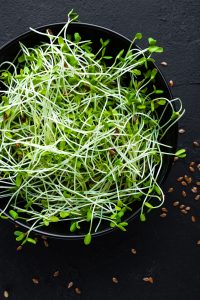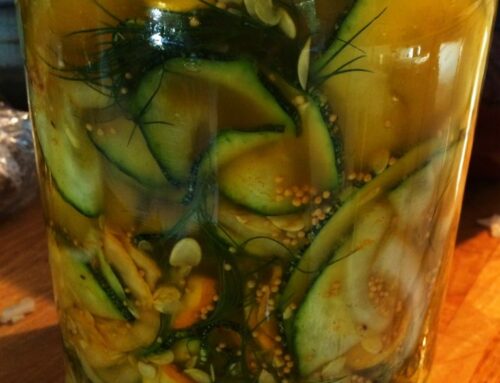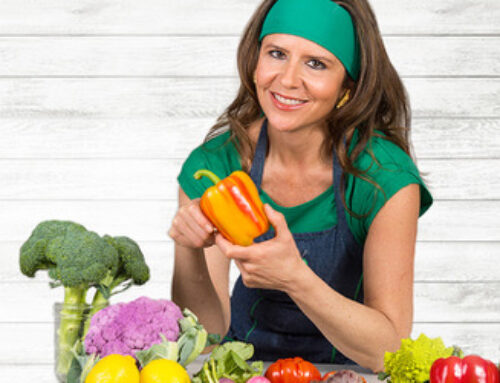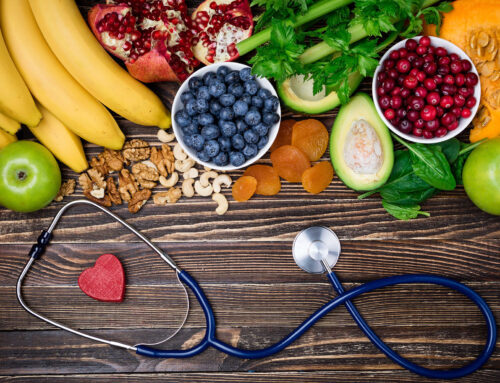by Vesanto Melina, MS, Registered Dietitian
Mung beans and lentils are seeds with the potential and life force to grow into large, strong plants. For this purpose, these little embryos contain a rich store of vitamins, minerals, proteins, fats and carbohydrates, all ready and waiting for the right conditions of heat, moisture and oxygen to be present in order to grow. As soon as seeds germinate, chemical changes occur, including many that provide us with health benefits.

Healthy vegetarian bowl dish with fresh flaxseed sprouts.
For example, when mung beans and lentils are sprouted the following changes occur:
- Protein is created; protein quality improves – with increased amounts of essential amino acids – and the digestibility of the protein present increases.
- Trypsin inhibitors (anti-nutrients which reduce protein digestibility) are destroyed during germination of mung beans and lentils.
- Starch is converted to the more easily assimilated simple sugars; glucose and fructose increase tenfold when mung beans are sprouted.
- Sprouting significantly increases the content of enzymes, including those that break down or begin the digestion of protein and starch.
- The carbohydrates that can produce gas (flatulence) largely disappear when mung beans are sprouted.
- Sprouting stimulates the production of quantities of antioxidants that protect us against disease.
- The vitamin C content of the original legume increases 17 times when lentils are sprouted and eight times when mung beans are sprouted.
- The riboflavin content of mung bean triples and in lentils it increases by 50 percent during germination. The content of other B vitamins also increases.
- Phytate-mineral complexes are broken down during sprouting, greatly increasing mineral availability.
- The small amounts of hemagglutinins present in raw lentils and mung beans are destroyed by germination, making these raw sprouts safe. Only sprout these small legumes, not the bigger ones such as chickpeas or other beans. These larger legumes contain too much of these hemagglutinins to be eaten in a raw form, although if you go on to cook the bigger beans these problematic components are completely destroyed. Thus, although sprouted mung beans and lentils are safe, the other legumes should be eaten in the cooked form only.
If we take mung beans, lentils and other sproutable seeds along when we are sailing far from ports or when camping in remote areas, we can have fresh sprout salads despite limited access to markets selling fresh produce. During winter months when one’s garden is not productive, sprouts can provide us with fresh food and an excellent source of vitamin C.
The equipment needed to grow sprouts is simple and economical. A one-quart (1 L) canning (mason) jar is sufficient for kitchen sprouting. A sprouting lid or mesh screen is needed for the top, to allow rinse water to flow in and out while keeping the sprouts in the jar. Plastic sprouting lids can be purchased at natural food stores for this purpose or you can put a piece of mesh screen or cotton cheesecloth across the mouth of the jar and hold it in place with a rubber band. A dish rack is helpful, although not essential, for holding the jar at an angle to completely drain the water after rinsing.
| Easy sprouts |
| 1/4 cup (60 ml) dried mung beans or 1/2 cup (125 ml) dried lentils 2 cups (500 ml) water (Makes 3 to 4 cups sprouts) |
| Put beans or lentils in a one-litre sprouting jar and add water. Put a mesh screen or sprouting lid on the jar and let stand at room temperature for 12-24 hours. Drain and rinse thoroughly with cool water, then drain again. Place jar, with screen, upside-down at a 450 angle over a saucer or dish rack so water may run off. Cover jar with a towel or place it away from light so sprouts can grow in the dark. Rinse and drain two or three times a day for three to five days, until a short tail is visible. Store the sprouts in a sealed container in the fridge for up to one week. |
[su_divider]

Vesanto thoroughly enjoys teaching Living Light’s Nutrition courses – come see for yourself!







